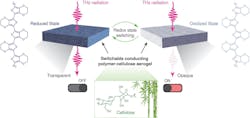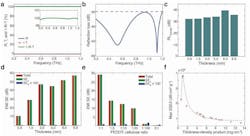Your Next Tunable Terahertz Attenuator Might Be an Aerogel
What you’ll learn:
- What is an aerogel and how is it fabricated?
- How aerogels can be created for use in terahertz signal paths.
- How aerogels perform in terahertz attention roles.
Attenuators, especially adjustable ones, are a vital part of the communication signal-path hardware. Providing this function in the terahertz band has been a challenge, but a team at the Linköping University (Sweden) devised and evaluated a non-intuitive approach.
They used aerogels—among the lightest of solid materials—made of cellulose and PEDOT:PSS, a material whose absorption of terahertz signals can be maximized and minimized via a redox reaction. (Note that aerogels are already used in some supercapacitors and for high-performance thermal insulation.)
Developing Aerogels for Terahertz Transmission
Here, using a chemical-vapor treatment, they were able to switch the pristine oxidized (conducting) aerogels to a reduced (insulating) state (Fig. 1).
1. The THz transmission can be switched on and off by controlling the redox states of conducting polymer aerogels made from sustainable cellulose and PEDOT materials.
[Quick chemistry-class reminder: (1) PEDOT:PSS is the common name for poly (3,4-ethylenedioxythiophene) polystyrene sulfonate (PEDOT:PSS), a widely used conducting polymer made of two isomers. (2) An oxidation-reduction (redox) reaction is a chemical reaction that involves a transfer of electrons between two substances; oxidation is the loss of electrons or an increase in the oxidation state, while reduction is the gain of electrons or a decrease in the oxidation state.]
For 1.5-mm-thick aerogels with moderate conducting polymer content, this led to a drastic increase in broadband THz transmission (0.1 to 10 THz) from 13% to 91%, and with negligible specular reflection (<0.1%). In a more-narrow spectral range around 1.2 THz, the transmission was modulated from only 2% to 90% upon switching. The process is reversible, and the aerogels could be re-oxidized to regain their THz transparency (Fig. 2).
2. THz properties of the conducting polymer-cellulose aerogels: (a) R, T, and 1-R-T of an aerogel in the THz range (inset: enlarged 1-R-T spectra in the THz range). (b) THz specular reflection loss (RL) of the same aerogel. (c) Comparison of average RL (RLaverage) for aerogels with different thicknesses. (d) Comparison of EMI SE and its contributions from absorption SEA and reflection SER (enlarged 100X to be seen in the graph) for aerogels of different thicknesses. (e) Comparison of EMI SE and its contributions from absorption SEA and reflection SER for aerogels of different ratios of PEDOT:PSS to cellulose. (f) The relation between max SSE/t and the product of thickness and density of the aerogels. (The dashed line is a fitted curve as a guide to the eye.) Conductive polymer-cellulose aerogel presented in a and b has a thickness of 6 mm, and its component ratio of PEDOT:PSS to cellulose is 1:1.
Conducting polymers have many advantages over other materials used to create tunable materials. Among other things, they’re biocompatible, durable, and have a great ability to be tuned. Their tunability comes from the ability to change the charge density in the material.
The PEDOT:PSS and cellulose were homogeneously distributed in the aerogel. The great advantages of cellulose are the relatively low production cost compared to other similar materials and that it’s a renewable material, which is key for sustainable applications (Fig. 3).
3. Redox state tunability and switchable THz transmission of conducting polymer-cellulose aerogels: (a) PEI (1) and HCl (2) vapor treatment for conducting polymer-cellulose aerogels. (b) Resistance of conducting polymer-cellulose aerogel at different redox states (normalized based on its initial resistance at oxidized state). (c) Images of the aerogels at different redox states. The aerogel used for panel (a-c) had a thickness of 1.5 mm and PEDOT:PSS to cellulose ratio of 1:10. Panels (df) present reversible tunable THz transmission for aerogels, for three different ratios of PEDOT:PSS to cellulose of (d) 1:10, (e) 1:100, and (f) 1:5. The THz transmission at three different states (oxidized, reduced, and re-oxidized) are displayed. The tuning ranges are highlighted by a light pink shading.
Aerogel Benefits and Possible Drawback
The aerogels are fabricated using aqueous solutions and don’t require complex fabrication procedures, thereby offering potential for large-scale sustainable production at a low cost. The fabricated and tested PEDOT:PSS/cellulose pairings had different ratios.
Further, they designed the aerogel for use in outdoor applications, making it water-repellent (hydrophobic) and suitable for natural defrosting via heating by sunlight. To do this, they modified the surface hydrophilicity of the aerogels to avoid water uptake. They also demonstrated that solar-induced heating can be used for efficient and passive removal of ice or frost layers.
One additional unique attribute of the aerogel-based variable attenuator—transition time—may argue against its use, in addition to needing a chemical process to adjust attenuation. Depending on various factors such as frequency range, beginning and ending attenuation values, and others, the time to go from one attenuation extreme to the other is on the order of between five and 30 minutes. That’s certainly going to be a consideration in many applications.
The work is detailed in their paper “Switchable Broadband Terahertz Absorbers Based on Conducting Polymer-Cellulose Aerogels” published in Advanced Science. There’s also a detailed Supplementary Information file as well as a 30-second video showing the aerogel being handled and submersed in a fluid.



